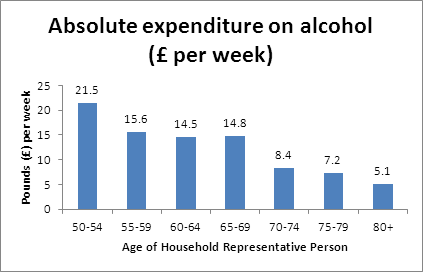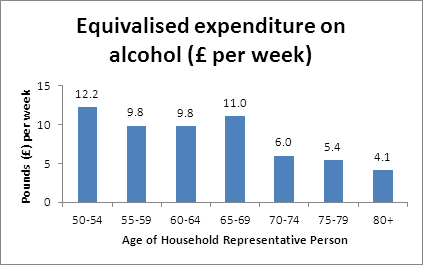Alcohol expenditure across the life-course
ILC-UK are working with PFRC at Bristol University to develop new a new piece of work exploring alcohol across the life-course. We have previously blogged on the topic (see here and here for example) and remain convinced that we need to better understand alcohol as a life-course issue.
Using data from the UK’s 2011 Living Costs and Food Survey, David Hayes at PFRC has begun to look at how expenditure on alcohol varies across the life-course. This analysis is run on 2,931 households headed by a person aged 50 and above. The data is weighted to be nationally representative.

PFRC then equivalised the data, meaning that household size was accounted for in our analysis (i.e. households with six occupants may have higher expenditure than single households, so we used the OECD equivalence scale to take account of household composition). The following picture emerged:

Looking at both absolute and equivalised expenditure, expenditure on alcohol decreases with age. Households where the household reference person is 80+ spend between a quarter and a third of the amount of households headed by someone aged 50-54. However, in both of the above graphs, we notice a rise in expenditure among the 65-69 year olds (more pronounced when looking at equivalised expenditure). Possible reasons for this could be more time due to retirement; more disposable income due to pensions and mortgages being paid off; as well as the combination of being retired but still generally mobile, with options to socialise more frequently than at earlier and later stages of their lives.
A complex relationship
However, as we may expect, the relationship between expenditure and alcohol is not as simple as this. Many older people spend a sizeable proportion of their weekly outgoings on alcohol, while some spend none at all. The relationship between alcohol expenditure and age is complex, and needs more sophisticated analysis to fully unravel the drivers of expenditure.
Numerous factors – including housing tenure, employment status, income, social class, geographical location, mobility and health – may affect patterns of expenditure on alcohol among the older population.
So what next?
Descriptive statistics, regression analysis and segmentation techniques (such as cluster analysis) will allow us to explore and divide the older population, based on their patterns of expenditure on alcohol. We will then be able to analyse these groups, tackling pertinent social research questions around health and lifestyle that can feed into policy, while also providing useful information to the marketing industry on expenditure and consumption habits among an ageing population.
If you are interested in working with us on this project, please do get in touch.
David Hayes, PFRC and David Sinclair, ILC-UK
Posted on 30 January 2014
This blog was originally posted on the ILC-UK blog
